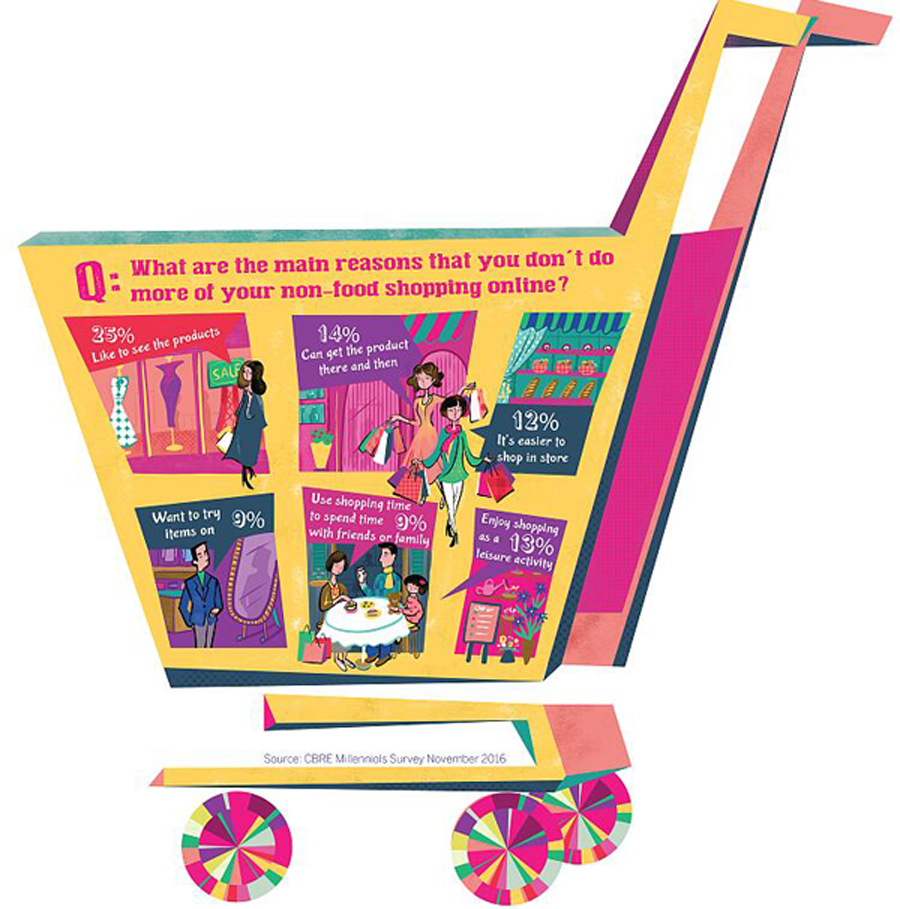Millennials drive offline markets
 |
|
MA XUEJING and SU JINGBO / CHINA DAILY |
Changing consumer preferences, shopping habits, and rising incomes force retailers to reshape strategies
Millennials aged 18-37 are now a crucial 415-million strong segment of Chinese consumers, constituting nearly one-third of the nation's total consumers. Their changing preferences, shopping habits and spending power are influencing retailers and brands alike to reshape their business strategies, promising to infuse fresh vigor into the economy.
One of the most striking aspects of this trend is the re-emergence of physical shopping, as opposed to online shopping, as a popular pastime-retail therapy, if you will.
For instaince, Zeng Yingqi, 26, an institutional client manager at a State-owned securities company, buys almost everything online, from single-prong hairpin to soft-leather tote, but still needs to shop once a week for leisure.
"Surely, I can get whatever I need on the internet. But it can't replace the shopping habit. In stores, I can see and touch the products, try them on, and also spend time with my friends."
Recent reports show that Chinese millennials, mostly born in the 1980s and 1990s, though internet-savvy, have a tendency to spend more time and money on experience-based consumption such as shopping at physical stores, traveling and dining out.
Brands are studying closely such consumers' shopping patterns, predilections. They are "entering their prime consumption years", according to a Goldman Sachs report.
China, which will soon be the world's largest consumer market, has been abuzz with e-commerce, mobile games and live streaming platforms. Brand-new online business models have been burgeoning in the digital era to woo the millennials.
But now, it seems, consumerism has come a full circle in China, with attention shifting back from mobile screens to real-world shopping.
A report by global real estate advisory firm CBRE China found that tech-savvy millennials do like to shop online, but only physical retail, particularly shopping centres, can provide them with the experiences and social elements they crave.
Tangibility and experience are listed as the top two reasons for millennial consumers to visit physical stores, according to CBRE's research.
"I think retailers should integrate their online channels and offline stores more deeply. I mean real integration," said Zeng, adding that several times, it took her days to find a pair of shoes in another branch of the same store. "The physical stores can curtail inventory and serve only as an experience center."
Ann Fishman, founder of Generational Targeted Marketing, said: "Millennials' concerns must be your concerns." She has been at the forefront of major generational trends for decades.
By 2025, Chinese millennials' aggregate income is estimated to surge to $3 trillion as average annual incomes increase from $5,900 to $13,000, according to Asian consumer research of Goldman Sachs.
Such an increase in spending power, the research said, would amount to more than half of the estimated $5 trillion that would be added to total US private consumption expenditure over the next 10 years, if the US were to sustain the compound annual growth rate of 3.7 percent that it achieved over the past decade.
So, retail marketers are racking their brains to figure out how to win over this most influential consumer segment.
For instance, Alibaba Group Holdings Ltd has tied up with department store chain Intime Retail Group Co. The partnership has reportedly given the e-commerce giant access to Intime's inventory and allowed its online customers to pick up orders from physical stores.
Other retailers are also adopting similar strategies.
Shanghai Malianghang (Hong Kong) Design Co Ltd, a three-year-old custom-made jewelry company that started online, opened the first retail store in Shanghai last year and planned to open up to 30 stores nationwide within two to three years.
Company CEO Bill Hu, a post-'90s person who manages a cohort of millennial staff, believes consumers should be able to "feel the products", and that it is essential for his customers to experience on their own how to use 3-D printing technology to make custom jewelry.
"At a time when winning customers online has become costlier, it is particularly important for online retailers to get the offline side up to standard," Hu said.
For its part, the Chinese government is also determined to strengthen online and offline integration in retail.













